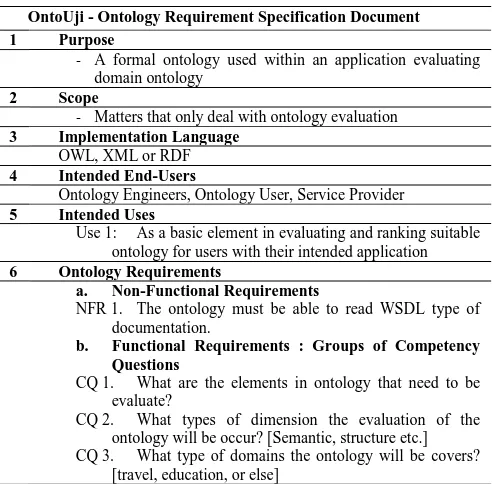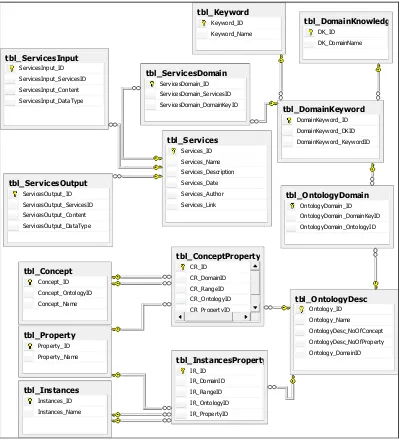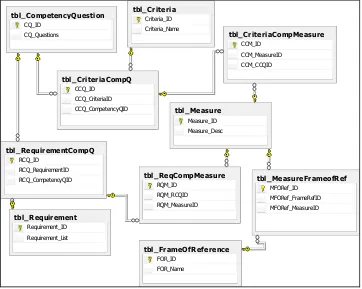69:6 (2014) 21–26 | www jurnalteknologi.utm.my | eISSN 2180–3722 |
Full paper
Jurnal
Teknologi
OntoUji–Ontology to Evaluate Domain Ontology for Semantic Web
Services Description
Nurhamizah Mohd-Hamka*, Radziah Mohamad
Department of Software Engineering, Faculty of Computing, Universiti Teknologi Malaysia, 81310 UTM Johor Bahru, Johor, Malaysia
*Corresponding author: mieza.hamka@gmail.com
Article history
Received :1 January 2014 Received in revised form : 15 February 2014 Accepted :18 March 2014
Graphical abstract
Abstract
Ontology evaluation has become an important aspect for selecting suitable ontology to be used within a system. User such as services provider has been proposed with variety of methodology to help in selecting ontology from the Web. Ontology has been used by service providers to describe the semantic part of their web services profile. Evaluating domain ontology for semantic Web services descriptions is currently in its early phase. Moreover the building of domain ontology itself requires greater attention because the ontological element for semantic web services description is not standardized in the current knowledge and thus requiring further refinement. There are studies conducted on transforming Web Services Description Language (WSDL) format into Ontology Web Language for Services (OWL-S) types of ontology to improve the services discovery. But since then, the ontologies were stored and retrieve locally, as well as ranked based on its history of selection or popularity. Criteria for ontology evaluation were then proposed to help users to select the suitable ontology to describe their web services description by achieving certain criteria measurement. By far, the users have problems because the current WSDL description does not signify the services profile. Hence, our study proposes an ontology called OntoUji, which will be used within the process of domain ontology evaluation to suit the required description of semantic web services.
Keywords: Ontology evaluation; web services description; ontology development; domain ontology O © 2014 Penerbit UTM Press. All rights reserved.
1.0 INTRODUCTION
Ontology is an abstraction of idea to represent concept within certain body of knowledge. The word ‘ontology’ comes from the philosophical world. However, Gruber introduced the term ‘ontology’ in the Computer Science area as ‘explicit specification of a conceptualization’ [1]. Semantic Web services ontology is an ontology framework that helps toward the discovery of web services [2]. There are number of ontology for Web services proposed in the literature such as OWL-S, WSMO and also First-Order Ontology for Web Services (FLOWS). FLOWS In particular, is known as an enhanced version of ontology elements within the OWL-S concepts aimed to increase the availability of service discovery. S study developed by Lara et al. was conducted to compare between OWL-S and WSMO approach [3]. The structure of the ontology for Web services refers to WSDL format documentation that receives W3C recommendation for Web services description language. These proposed ontology help to describe the Web services in order to facilitate service discovery made by service agent.
Semantic Web services were introduced between the integration of both Web services and Semantic Web technologies. Service descriptions have to be viewed in ontological manners in order to match with the suitable domain ontology in the Web. The
matched services descriptions with the domain ontology will show the data availability for web services description which are gathered within OWL-S and WSMO. This study developed a UML class diagram which refers to the evaluation elements for domain ontology and converted them into ontological conceptual element and relational database diagram. This idea was inspired by the software engineering ontology study conversion from UML diagram made by Wongthongtham et al. which focused on the context of service profile that will be mapped into OWL format.
evaluation equipment for the entire ontology in Web. In semantic Web services description, the services provider deals with web services and needs domain ontology for semantic Web services to describe the services. Unfortunately, they have problems in selecting the suitable domain ontology from the Web to describe their services as the domain ontology for semantic web services are different from domain ontology from Semantic Web because the Web services profile includes input and output of services with different data types on its own [5]. So, during the evaluation process, the study needs to consider the data types of the services profile for services input and output.
Ontology evaluation is a process of verification and validation of ontology, i.e. whether the ontology satisfies the requirements within the application usage, or the built ontology achieved certain criteria objectives [6]. Although evaluating ontology is not a simple task, it is one way to avoid getting inconsistent ontology because it had been published in Web frequently [7]. As such, the identification of suitable criteria and evaluation methods before running ontology evaluation process is recommended [4].
Evaluation ontology or OntoUji, was developed to be included during the process of evaluating domain ontology for semantic Web services. OntoUji conceptualizes the elements that will be needed during the evaluation of domain ontology. The following section explains the ideas and methodologies of developing OntoUji and the evaluation ontology for description of web services on selecting suitable domain ontology. The methodology follows Noy (2000) on 101 Ontology tutorial and competency questions methodology by Grüninger (1995) [8, 9].
2.0 RELATED WORKS
Identifying competency questions is one of the elements that need to be included during the development of the ontology, i.e. to check whether the ontology able to answer questions relevant to its domain to achieve the objectives of the ontology construction [9]. Since our proposed ontology focused on evaluating domain ontology for semantic web services description, we included competency questions into our concept of OntoUji.
Yu et al. proposed a methodology that grouped criteria, competency questions and requirement related to each other for the purpose of ontology evaluation [10]. The mapping between criteria and the requirements are then merged with related measurement to fulfill the criteria of the evaluation of the ontology. The ROMEO methodologies were referred to help us gather the criteria, the definition of the criteria and measures during the construction of OntoUji ontology concept. The concept of the OntoUji also consists of documentations for Web services profile in order to support searching for the suitable ontology for the services description.
Each criteria of evaluation relate to certain requirements. For example, criteria of coverage for domain ontology requires concept in the ontology to cover most of the terms related to certain domain of knowledge it represented [11]. Former researcher like Gómez-pérez (2001) and Martínez-romero (2012) developed the criteria for ontology evaluation list which includes, for example, coverage and correctness [6, 12]. The dimensional aspect of ontology evaluation is grouped to enable the view of different approach for ontology evaluation within different dimensions [4]. The aforementioned study helped us to relate each component in our proposed ontology concepts with the evaluation of domain ontology process.
2.1 Competency Questions
The competency questions help the construction of the ontology to be more focused within the domain knowledge it represent. In the whole evaluation process, the ontology must be able to answer several competency questions to relate it suitable measures of quality that the ontology need to fulfill:
1. What are the elements within domain ontology need to be evaluated for web services description?
2. What are the criteria of the ontology evaluation?
The first question will be answered during the development section on identifying the elements needed to evaluate domain ontology. The second question will be answered during the evaluation of the ontology process. This helps to gather criteria and the measures that related to its requirements of evaluation.
3.0 ONTOUJI DEVELOPMENT
The developmental phase of OntoUji concepts consists of the evaluation elements to be included during the validation and verification of the selected domain ontology. The ontological structures for OntoUji were developed based on
Figure 1 (development ontology flowchart). Table 1 describes the requirement description for OntoUji ontology.
Table 1 Requirements Documentation for OntoUji Development
OntoUji - Ontology Requirement Specification Document 1 Purpose
- A formal ontology used within an application evaluating domain ontology
2 Scope
- Matters that only deal with ontology evaluation
3 Implementation Language
OWL, XML or RDF
4 Intended End-Users
Ontology Engineers, Ontology User, Service Provider
5 Intended Uses
Use 1: As a basic element in evaluating and ranking suitable ontology for users with their intended application
6 Ontology Requirements
a. Non-Functional Requirements
NFR 1. The ontology must be able to read WSDL type of documentation.
b. Functional Requirements : Groups of Competency Questions
CQ 1. What are the elements in ontology that need to be evaluate?
CQ 2. What types of dimension the evaluation of the ontology will be occur? [Semantic, structure etc.] CQ 3. What type of domains the ontology will be covers?
[travel, education, or else]
4.0 UML FOR ONTOUJI
OntoUji has to establish its own ontological structure to encourage further references. However, researchers from a previous study discussed the description of web services description ontology states that web services domain ontology and domain ontology in Semantic Web are different from one another [5]. The web services domain ontology had to specify the data type consists of the input and output of services because it is the main functions for the ontological concept. The construction of the OntoUji need to include data types for the input and output of services element during the evaluation of the domain ontology.
Our study refers to the process of converting UML class diagram in the structure of ontology that converts Software Engineering Object Oriented relationship into ontological structure [13]Error! Reference source not found.. Our first step is to construct OntoUji UML model from the ontological structure which is a reverse process and differs [13]. From the UML, we developed a database diagram of part 1 in Figures 2 and
Figure 3 as part 2 of OntoUji.
From the UML above, the OntoUji is divided into two groups, part 1 and part 2. Part 1 of the UML diagram indicates elements that are connected between services description and ontology elements. We linked the concept of Ontology and Services with the domain of knowledge based on keywords.
4.1 OntoUji
The conversion of UML model to ontology concept were adopted from Software Engineering ontology from Wongthongtham et. al.
(2009). Since ontology is an evolving process, there will have refined ontology structure in future due to increase of new techniques, methods or requirements in evaluating ontology. OntoUji will be used within evaluation of domain ontology in an application with several selected criteria measurement.
Figure 4 indicates the ontology conceptual diagram for OntoUji from database diagram of part 1. We divided the ontology by two groups of database diagram, to point out which part of the OntoUji that focused on the description of web services and which part contributes during the evaluation of the domain ontology. The ontological diagram part 1 describes the elements within the web services description and connected domain ontology.
Part 2 (Figure 5) of the ontological concepts describe the elements included in the evaluation of domain ontology. It focuses more on the process of evaluating the ontology and the element for the ontological concept gathered from the literature. The connection between these concepts are also inspired by the framework of ontology evaluation and ROMEO methodology that includes the elements of criteria, competency questions and requirements matching to each other [10].
5.0 ONTOLOGY VALIDATION
The most recent tool used for validation of ontology is OOPS! [14]. Other tools were proposed by OntoQA and OWL Validator by Manchester University [15]. The development of OntoUji by Protégé tools, were validated by the reasoner plugged in the Protege. The validation of OntoUji are using Pellet reasoner within the Protégé tools. The reasoner checks for the consistency of the ontology.
Figure 6 shows part of the result of validation from the ontology metrics within the Protégé tools.
6.0 CONCLUSION AND FUTURE WORKS
The aforementioned concepts situated in OntoUji will evaluate the retrieved domain ontology in Web for description of web services. Our future work will handle the search and selection of domain ontology for services agent to apply for their web services. The collaboration between OntoUji part 1 and part 2 will be connected during the evaluation process of domain ontology in future works. We proposed to combine the ontology and Web services from similar domain with the keywords of the domain gained from the WordNet database.The ontology will participate in the evaluation of searched ontology retrieve from Web. The selected criteria of ontology evaluation will also be adapted during the process to improve towards the evaluation of ontology in their aspect of criteria. By this, the service agent will easily select the suitable domain ontology to describe its semantic web services.
Literature Extraction focus on Semantic Web Services
Extract Criteria of Ontology Evaluation
Extract Elements Used during Evaluation
Conceptualize Element into Concept in Ontology Built property relation and individuals of the
ontology Validate Ontology
Correct the inconsistency occur
within concept or relation in ontology Consistent ontology?
Start
Identify the Domain and Scope of the
Ontology
Identify competency
questions
List out concept that will be included within the ontology
Extract element within WSDL type
document
No
Need expansion towards ontology?
Yes
Yes
No
tbl_Services
Services_ID Services_Name Services_Description Services_Date Services_Author Services_Link
tbl_ServicesInput
ServicesInput_ID ServicesInput_ServicesID ServicesInput_Content ServicesInput_DataType
tbl_ServicesOutput
ServicesOutput_ID ServicesOutput_ServicesID ServicesOutput_Content ServicesOutput_DataType
tbl_ServicesDomain
ServicesDomain_ID ServicesDomain_ServicesID
ServicesDomain_DomainKeyID tbl_DomainKeyword
DomainKeyword_ID DomainKeyword_DKID DomainKeyword_KeywordID
tbl_DomainKnowledge DK_ID
DK_DomainName tbl_Keyword
Keyword_ID Keyword_Name
tbl_OntologyDomain
OntologyDomain_ID OntologyDomain_DomainKeyID OntologyDomain_OntologyID
tbl_OntologyDesc
Ontology_ID Ontology_Name OntologyDesc_NoOfConcept OntologyDesc_NoOfProperty Ontology_DomainID
tbl_Concept
Concept_ID Concept_OntologyID Concept_Name
tbl_ConceptProperty
CR_ID CR_DomainID CR_RangeID CR_OntologyID CR_PropertyID
tbl_Instances
Instances_ID Instances_Name
tbl_InstancesProperty
IR_ID IR_DomainID IR_RangeID IR_OntologyID IR_PropertyID
tbl_Property Property_ID Property_Name
tbl_CompetencyQuestion CQ_ID
CQ_Questions
tbl_Criteria Criteria_ID Criteria_Name
tbl_CriteriaCompMeasure CCM_ID
CCM_MeasureID CCM_CCQID
tbl_CriteriaCompQ CCQ_ID
CCQ_CriteriaID CCQ_CompetencyQID
tbl_FrameOfReference FOR_ID
FOR_Name
tbl_Measure Measure_ID Measure_Desc
tbl_MeasureFrameofRef MFORef_ID
MFORef_FrameRefID MFORef_MeasureID tbl_ReqCompMeasure
RQM_ID RQM_RCQID RQM_MeasureID tbl_Requirement
Requirement_ID Requirement_List tbl_RequirementCompQ
RCQ_ID RCQ_RequirementID RCQ_CompetencyQID
Figure 3 Relational database diagram from Part 2 OntoUji concepts
Figure 5 OntoUji, ontology conceptual diagram of UML OntoUji Part 2
Figure 6 Ontology metric in protégé view validation from pellet reasoner
References
[1] T. R. Gruber. 1993. Toward Principles for the Design of Ontologies Used for Knowledge Sharing. Int. J. Human-Computer Stud. 907–928. [2] X. Wang and W. A. Halang. 2013. Discovery and Selection of Semantic
Web Services. Berlin, Heidelberg: Springer Berlin Heidelberg. 453: 1– 132.
[3] R. Lara, D. Roman, A. Polleres, and D. Fensel. 2004. A Conceptual Comparison of WSMO and OWL-S. In Web Services. L.-J. (LJ) Zhang and M. Jeckle, Eds. Berlin, Heidelberg: Springer Berlin Heidelberg. 3250: 254–269.
[4] D. Vrandečić. 2009. Ontology Evaluation. In Handbook on Ontologies, 2nd ed. 20., S. Staab and R. Studer, Eds. Berlin, Heidelberg: Springer Berlin Heidelberg. 293–313.
[5] M. Sabou, C. Wroe, C. Goble, and H. Stuckenschmidt. 2005. Learning Domain Ontologies for Semantic Web Service Descriptions. Web Semant. Sci. Serv. Agents World Wide Web. 3(4): 340–365.
[6] A. Gómez-pérez. 2001. Evaluation of Ontologies. Int. J. Intell. Syst.
16(3): 391–409.
[7] Y. Netzer, D. Gabay, M. Adler, Y. Goldberg, and M. Elhadad. 2009. Ontology Evaluation through Text Classification. In Advances in Web
and Network Technologies, and Information Management. 5731. L.
Chen, C. Liu, X. Zhang, S. Wang, D. Strasunskas, S. L. Tomassen, J. Rao, W.-S. Li, K. S. Candan, D. K. W. Chiu, Y. Zhuang, C. A. Ellis, and K.-H. Kim, Eds. Springer Berlin Heidelberg. 210–221.
[8] N. F. Noy and D. L. Mcguinness. 2000. Ontology Development 101 : A Guide to Creating Your First Ontology. 1–25.
[9] M. Grüninger and M. Fox. 1995. Methodology for the Design and Evaluation of Ontologies. Work. Basic Ontol. Issues Knowl. Sharing, IJCAI-95, Montr.
[10] J. Yu, J. a. Thom, and A. Tam. 2009. Requirements-oriented Methodology for Evaluating Ontologies. Inf. Syst. 34(8): 766–791. [11] M. Sabou. 2006. Building Web Service Ontologies. Dutch Graduate
School for Information and Knowledge Systems.
[12] M. Martínez-romero, J. M. Vázquez-naya, J. Pereira, and A. Pazos. 2012. A Multi-criteria Approach for Automatic Ontology Recommendation Using Collective Knowledge. In Recommender Systems for the Social Web. 32: 89–103.
[13] P. Wongthongtham, F. K. Hussain, E. Chang, and T. S. Dillon. 2009. Multi-site Software Engineering Ontology Instantiations Management Using Reputation Based Decision Making. In Advances in Web Semantics I. 199–218.
[14] M. Poveda-villalón, M. C. Suárez-figueroa, and A. Gómez-pérez. 2012. Did You Validate Your Ontology ? OOPS ! Proc. ESWC2012. 4–8. [15] S. Tartir and I. B. Arpinar. 2007. Ontology Evaluation and Ranking using




